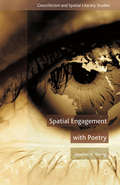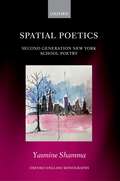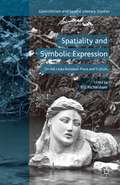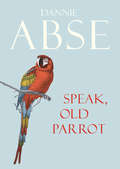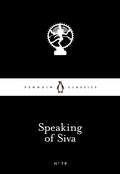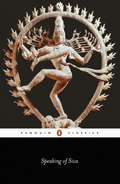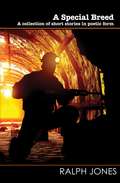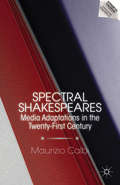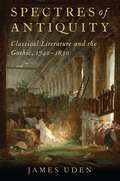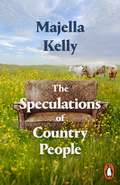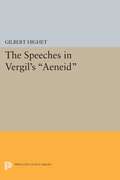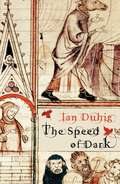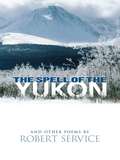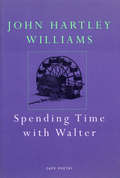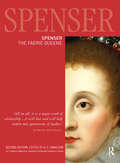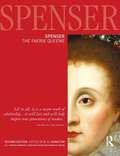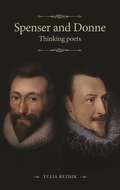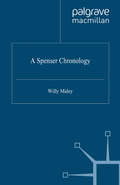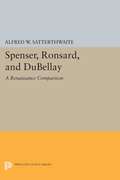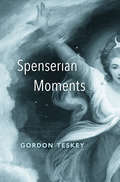- Table View
- List View
Spatial Engagement with Poetry (Geocriticism and Spatial Literary Studies)
by H. YeungDrawing from a broad range of contemporary British poets, including Thomas Kinsella, Kathleen Jamie, and Alice Oswald, this study examines the inherently spatial and affective nature of our engagement with poetry. Adding to the expanding field of geocritical studies, Yeung specifically discusses ideas of space and constructions of voice in poetry.
Spatial Poetics: Second Generation New York School Poetry (Oxford English Monographs)
by Yasmine ShammaWhat is the relationship between the spaces we inhabit and the spaces we create? Does living in a messy downtown New York City apartment automatically translate to writing a messy New York School poem? This volume addresses the 'environment' of the urban apartment, illuminating the relationship between the structures of New York City apartments and that of New York School poems. It utilizes the lens of urban and spatial theory to widen the possibilities afforded by New Critical and reader-response readings of this postmodern American poetry. In drawing this connection between consciousness and form, it draws on various senses of the environment as informing influence, inviting avant-garde American poetry to be reconsidered as uniquely organic in its responsiveness to its surroundings. Focusing exclusively and comprehensively on Second Generation New York School poetry, this is the first book-length study to attend to the poetry of this postmodern American movement, encouraging American poetry scholars to resituate New York School poetry within larger critical narratives of postmodern innovation.
Spatial Poetics: Second Generation New York School Poetry (Oxford English Monographs)
by Yasmine ShammaWhat is the relationship between the spaces we inhabit and the spaces we create? Does living in a messy downtown New York City apartment automatically translate to writing a messy New York School poem? This volume addresses the 'environment' of the urban apartment, illuminating the relationship between the structures of New York City apartments and that of New York School poems. It utilizes the lens of urban and spatial theory to widen the possibilities afforded by New Critical and reader-response readings of this postmodern American poetry. In drawing this connection between consciousness and form, it draws on various senses of the environment as informing influence, inviting avant-garde American poetry to be reconsidered as uniquely organic in its responsiveness to its surroundings. Focusing exclusively and comprehensively on Second Generation New York School poetry, this is the first book-length study to attend to the poetry of this postmodern American movement, encouraging American poetry scholars to resituate New York School poetry within larger critical narratives of postmodern innovation.
Spatial Representations and the Jacobean Stage: From Shakespeare to Webster
by R. WestSpatial Representations and the Jacobean Stage offers a timely alternative to theatre criticism's neglect of the intensely spatial character of theatrical performance. The book shows that early modern audiences were highly aware of the spatial aspects of the stage. West examines the ways Jacobean dramatists used stage space to explore the spatial transformations of early modern society - social mobility, wandering populations, rural enclosure, sea travel, localized empirical thought. Dramas by Shakespeare, Jonson, Middleton and Webster are scrutinized for their treatment of these controversial themes.
Spatiality and Symbolic Expression: On the Links between Place and Culture (Geocriticism and Spatial Literary Studies)
by Bill RichardsonIn this volume, scholars from a wide range of fields within the humanities explore the links between space and place and their relation to cultural expression. This collection shows that a focus on the spatial can help elucidate important facets of symbolic expression and cultural production, whether it be literature, music, dance, films, or art.
Speak, Old Parrot
by Dannie Abse2013 marks Dannie Abse's 90th birthday. In his lifetime he has published an astonishing array of work including poetry, fiction, criticism, plays and autobiography but it is as a poet that he is best known and loved. In Speak, Old Parrot he returns to themes of loss, love, medicine and its moral implications, the nature of creativity, Jewish folk tradition and the passing of time. The poems are observant of the outside world as well as the inner life and emotions but most of all they are a joy to read.
Speaking of Siva
by A. K. Ramanujan'To the utterly at-one with Sivathere's no dawn.'Meditative, deeply personal poems to the god Siva, from four major Hindu saints.Introducing Little Black Classics: 80 books for Penguin's 80th birthday. Little Black Classics celebrate the huge range and diversity of Penguin Classics, with books from around the world and across many centuries. They take us from a balloon ride over Victorian London to a garden of blossom in Japan, from Tierra del Fuego to 16th-century California and the Russian steppe. Here are stories lyrical and savage; poems epic and intimate; essays satirical and inspirational; and ideas that have shaped the lives of millions.Mahadeviyakka (10th century), Basavaa, Devara Dasimayya and Allama Prabhu (12th century).
Speaking of Siva
by A. K. RamanujanSpeaking of Siva is a selection of vacanas or free-verse sayings from the Virasaiva religious movement, dedicated to Siva as the supreme god. Written by four major saints, the greatest exponents of this poetic form, between the tenth and twelfth centuries, they are passionate lyrical expressions of the search for an unpredictable and spontaneous spiritual vision of 'now'. Here, yogic and tantric symbols, riddles and enigmas subvert the language of ordinary experience, as references to night and day, sex and family relationships take on new mystical meanings. These intense poems of personal devotion to a single deity also question traditional belief systems, customs, superstitions, image worship and even moral strictures, in verse that speaks to all men and women regardless of class and caste.
A Special Breed: A collection of poetry (Wordcatcher Modern Poetry)
by Ralph JonesA Special Breed is a collection of poems written from the experiences of a former coal miner. The poems tell of the coal face, that only a coal miner could describe. The stories are sometimes harrowing, but if you close your eyes and use your imagination you may be able to envisage the life of a coal face worker. You may also get an insight into the friendship and camaraderie of the coal miners world. A world where they had to watch each others backs on the coal face, and wash each others back in the showers. The world of men who were a special breed, a special breed indeed.
Spectral Shakespeares: Media Adaptations in the Twenty-First Century (Reproducing Shakespeare)
by M. CalbiSpectral Shakespeares is an illuminating exploration of recent, experimental adaptations of Shakespeare on film, TV, and the web. Drawing on adaptation studies and media theory as well as Jacques Derrida's work, this book argues that these adaptations foreground a cluster of self-reflexive "themes" - from incorporation to reiteration, from migration to addiction, from silence to survival - that contribute to the redefinition of adaptation, and Shakespearean adaptation in particular, as an unfinished and interminable process. The "Shakespeare" that emerges from these adaptations is a fragmentary, mediatized, and heterogeneous presence, a spectral Shakespeare that leaves a mark on our contemporary mediascape.
Spectres of Antiquity: Classical Literature and the Gothic, 1740-1830
by James UdenGothic literature imagines the return of ghosts from the past. But what about the ghosts of the classical past? Spectres of Antiquity is the first full-length study to describe the relationship between Greek and Roman culture and the Gothic novels, poetry, and drama of the eighteenth and early nineteenth centuries. Rather than simply representing the opposite of classical aesthetics and ideas, the Gothic emerged from an awareness of the lingering power of antiquity. The Gothic reflects a new and darker vision of the ancient world: no longer inspiring modernity through its examples, antiquity has become a ghost, haunting contemporary minds rather than guiding them. Through readings of works by authors including Horace Walpole, Ann Radcliffe, Matthew Lewis, Charles Brockden Brown, and Mary Shelley, Spectres of Antiquity argues that these authors' plots and ideas preserve the remembered traces of Greece and Rome. James Uden provides evidence for many allusions to ancient texts that have never previously been noted in scholarship, and he offers an accessible guide both to the Gothic genre and to the classical world to which it responds. In fascinating and compelling detail, Spectres of Antiquity rewrites the history of the Gothic, demonstrating that the genre was haunted by a far deeper sense of history than has previously been assumed.
Spectres of Antiquity: Classical Literature and the Gothic, 1740-1830
by James UdenGothic literature imagines the return of ghosts from the past. But what about the ghosts of the classical past? Spectres of Antiquity is the first full-length study to describe the relationship between Greek and Roman culture and the Gothic novels, poetry, and drama of the eighteenth and early nineteenth centuries. Rather than simply representing the opposite of classical aesthetics and ideas, the Gothic emerged from an awareness of the lingering power of antiquity. The Gothic reflects a new and darker vision of the ancient world: no longer inspiring modernity through its examples, antiquity has become a ghost, haunting contemporary minds rather than guiding them. Through readings of works by authors including Horace Walpole, Ann Radcliffe, Matthew Lewis, Charles Brockden Brown, and Mary Shelley, Spectres of Antiquity argues that these authors' plots and ideas preserve the remembered traces of Greece and Rome. James Uden provides evidence for many allusions to ancient texts that have never previously been noted in scholarship, and he offers an accessible guide both to the Gothic genre and to the classical world to which it responds. In fascinating and compelling detail, Spectres of Antiquity rewrites the history of the Gothic, demonstrating that the genre was haunted by a far deeper sense of history than has previously been assumed.
The Speculations of Country People
by Majella KellyThe astonishing poetry debut exploring hidden histories, mythical landscapes and self-discovery in the face of limits on women's bodily autonomyIn 2017, the presence of a mass grave was confirmed in a disused sewage system in Tuam, County Galway. In it were the bodies of infants - wards of the Bon Secours Mother and Baby Home, where from 1925 to 1961 the children of unmarried women were sent to live their lives in the care of nuns. Their deaths were the result of a conservative culture which, under the influence of the Church, took a prurient interest in women's private lives and bodies.In The Speculations of Country People, her hauntingly lyrical debut collection, Majella Kelly reckons with that legacy. She traces the journeys of women in our own day, from controlling relationships to sexual reawakening and new happiness. The speculations of the title are in part those of gossip, the chatter of small communities everywhere; but they are also those of a local, very Irish mythos, in which pagan and Christian - and truth and legend - blend and blur.Here, then, are hares and selkies, a seductive 'master otter' of 'fabulous elegance' who might carry a woman away in the night; here is the last man on Omey Island; here a retired stuntman, dragging his bed of rusty nails along the beach. And here - quiet, against the beauty and loneliness of the Connemara landscape - are the little bones that wash up on shores or stick from the earth to speak of what has been.
The Speeches in Vergil's "Aeneid"
by Gilbert HighetIn the Aeneid men, women, gods, and goddesses are characterized by the speeches assigned to them far more than by descriptions of their appearance or behavior. Most of the speeches are highly emotional and individualized, reminding us of the most powerful utterances of Greek tragedy.Gilbert Highet has analyzed all the speeches in the Aeneid, using statistical techniques as well as more traditional methods of scholarship. He has classified the speeches; identified their models in earlier Greek and Latin literature; analyzed their structure; and discussed their importance in the portrayal of character. He finds that Vergil used standard rhetorical devices with discretion, and that his models were poets rather than orators. Nevertheless, this study shows Vergil to have been a master dramatist as well as a great epic poet.Originally published in 1972.The Princeton Legacy Library uses the latest print-on-demand technology to again make available previously out-of-print books from the distinguished backlist of Princeton University Press. These editions preserve the original texts of these important books while presenting them in durable paperback and hardcover editions. The goal of the Princeton Legacy Library is to vastly increase access to the rich scholarly heritage found in the thousands of books published by Princeton University Press since its founding in 1905.
The Speed of Dark
by Ian DuhigIan Duhig's The Speed of Dark is structured around his astonishing reworking of the text of Le Roman de Fauvel, a medieval text that railed against the corruption of the 12th-century French court and church. In Duhig's hands, however, the tale of the power-mad horse-king Fauvel gains a terrifying and almost prophetic contemporary relevance, and is identified with more recent crusades, crazed ambitions and insatiable greeds. Elsewhere Duhig's many admirers will be delighted by his new ballads and elegies, his erudite high jinks and his low gags - with which he builds on the new imaginative territory he staked out in The Lammas Hireling to such universal acclaim. The Speed of Dark again shows Duhig as one the most capacious and brilliant minds in contemporary poetry. 'The most original poet of his generation' Carol Ann Duffy, Guardian 'His poetry is learned, rude, elegant, sly and funny, mixing gilded images, belly-laughs and esoteric lore about language (including Irish), art, history, politics and children's word-games' Ruth Padel, Independent on Sunday 'Duhig telescopes topical allusions, scholarly references and coarse humour into tightly-shaped, surreal poems which burst open with explosive moral force' Alan Brownjohn, Sunday Times
The Spell of the Yukon and Other Poems
by Robert Service"There are strange things done in the midnight sun," declared Robert Service as he related the fulfillment of a dying prospector's request. "The Cremation of Sam McGee" was based on one of many peculiar tales he heard upon his 1904 arrival in the Canadian frontier town of Whitehorse. Less than a decade after the Klondike gold rush, many natives and transplants remained to tell stories of the boom towns that sprang up with the sudden influx of miners, gamblers, barflies, and other fortune-seekers. Service's compelling verses — populated by One-Eyed Mike, Dangerous Dan McGrew, and other colorful characters — recapture the era's venturesome spirit and vitality.In this, his best-remembered work, the "common man's poet" and "Canadian Kipling" presents thirty-four verses that celebrate the rugged natural beauty of the frozen North and the warm humanity of its denizens. Verses include "The Shooting of Dan McGrew" ("A bunch of the boys were whooping it up in the Malamute saloon"), "The Heart of the Sourdough" ("There where the mighty mountains bare their fangs unto the moon"), and "The Call of the Wild" (Have you gazed on naked grandeur where there's nothing else to gaze on"). Generations have fallen under the spell of these poems, which continue to enchant readers of all ages.
Spending Time With Walter (Cape Poetry Ser.)
by John Hartley WilliamsThe long poem at the centre of John Hartley Williams' new collection is a dramatic monologue narrated by a laconic, possibly lamed, forest dweller, a lowly crewmember on a barge travelling an unnamed waterway. Some of his remarks are addressed to his talisman, the shrunken head of an African tribesman. The barge carries a sinister cargo and its captain has a preference for sadistic sex. Other poems in the book undertake journeys - to Northern Cyprus, China, medieval France, Florida - but like 'The Barge' they're not exactly travel poems, more poems which travel. Welcome to the unsettling world of John Hartley Williams, whose restless, inexhaustible imagination, originality and maverick humour have enlivened contemporary poetry for years. Paranoid, erotic, disturbed and disturbing, these are bulletins from a dislocated, parallel world that excites, entertains and terrifies - and often feels more real to us than our own.
Spenser: The Faerie Queene
by A. C. HamiltonThe Faerie Queene is a scholarly masterpiece that has influenced, inspired, and challenged generations of writers, readers and scholars since its completion in 1596. Hamilton's edition is itself, a masterpiece of scholarship and close reading. It is now the standard edition for all readers of Spenser. The entire work is revised, and the text of The Faerie Queene itself has been freshly edited, the first such edition since the 1930s. This volume also contains additional original material, including a letter to Raleigh, commendatory verses and dedicatory sonnets, chronology of Spenser's life and works and provides a compilation of list of characters and their appearances in The Faerie Queene.
Spenser: The Faerie Queene
by A. C. HamiltonThe Faerie Queene is a scholarly masterpiece that has influenced, inspired, and challenged generations of writers, readers and scholars since its completion in 1596. Hamilton's edition is itself, a masterpiece of scholarship and close reading. It is now the standard edition for all readers of Spenser. The entire work is revised, and the text of The Faerie Queene itself has been freshly edited, the first such edition since the 1930s. This volume also contains additional original material, including a letter to Raleigh, commendatory verses and dedicatory sonnets, chronology of Spenser's life and works and provides a compilation of list of characters and their appearances in The Faerie Queene.
Spenser and Donne: Thinking poets
by Richard Danson Brown Christopher Dean Johnson Niranjan Goswami Kathryn Walls Patrick Cheney Anne Lake Prescott Elizabeth Harvey Ramie Targoff Linda Gregerson Ayesha Ramachandran David Marno Jane Grogan Anne FogartyThe names Edmund Spenser and John Donne are typically associated with different ages in English poetry, the former with the sixteenth century and the Elizabethan Golden Age, the latter with the ‘metaphysical’ poets of the seventeenth century. This collection of essays, part of The Manchester Spenser series, brings together leading Spenser and Donne scholars to challenge this dichotomous view and to engage critically with both poets, not only at the sites of direct allusion, imitation, or parody, but also in terms of common preoccupations and continuities of thought, informed by the literary and historical contexts of the politically and intellectually turbulent turn of the century. Juxtaposing these two poets, so apparently unlike one another, for comparison rather than contrast changes our understanding of each poet individually and moves towards a more holistic, relational view of their poetics.
Spenser and Donne: Thinking poets (The Manchester Spenser)
by Yulia RyzhikThis edited collection of essays, part of The Manchester Spenser series, brings together leading Spenser and Donne scholars to challenge the traditionally dichotomous view of these two major poets and to shift the critical conversation towards a more holistic, relational view of the two authors’ poetics and thought.
Spenser and Literary Pictorialism
by John B. BenderFocusing, framing, scanning—the language of film—and Gombrich's studies in the psychology of perception are used by John Bender to isolate pictorial effects and devices in literature. The theory that he proposes, grounded in his analysis of Spenser, "the painter of poets," discriminates between the descriptive and the pictorial in poetry.Originally published in 1972.The Princeton Legacy Library uses the latest print-on-demand technology to again make available previously out-of-print books from the distinguished backlist of Princeton University Press. These editions preserve the original texts of these important books while presenting them in durable paperback and hardcover editions. The goal of the Princeton Legacy Library is to vastly increase access to the rich scholarly heritage found in the thousands of books published by Princeton University Press since its founding in 1905.
A Spenser Chronology: Spenser Chronology (Author Chronologies Series)
by W. Maley`...a valuable and welcome book; it belongs in any library that has pretensions of supporting Spenser scholarship.' - Russel J. Meyer, Spenser Newsletter A Spenser Chronology is the first serious attempt to map out in concrete detail all of the known facts concerning the poet Edmund Spenser, a major canonical author whose entire literary career was spent in Ireland. This book charts Spenser's parallel vocations of Elizabethan planter and Renaissance writer, outlining the activities, appointments and whereabouts of a prominent Irish colonist, and shedding new light on the life of one of the most important figures in English literary history.
Spenser, Ronsard, and DuBellay
by Alfred W. SatterthwaiteAlthough it has been recognized that Edmund Spenser's poetry owes a debt to the work of the French poets of the Pléiade, particularly to Joachim du Bellay and Pierre de Ronsard, there has been no critical analysis of this relationship. Mr. Satterthwaite compares the work of the three poets, showing the relation between the English movement to write quantitative verse and the French experiments in vers mesures. He discusses the attitudes of the poets to their Muses and to contemporary literature, their ideas of time and mutability, their moral (or amoral) views of literature and of life their religious orientation, and their use of the Platonic and neo-Platonic theories that were a part of the inherited culture of the Renaissance.Originally published in 1960.The Princeton Legacy Library uses the latest print-on-demand technology to again make available previously out-of-print books from the distinguished backlist of Princeton University Press. These editions preserve the original texts of these important books while presenting them in durable paperback and hardcover editions. The goal of the Princeton Legacy Library is to vastly increase access to the rich scholarly heritage found in the thousands of books published by Princeton University Press since its founding in 1905.
Spenserian Moments
by Gordon TeskeyGordon Teskey restores Edmund Spenser to prominence, revealing his epic The Faerie Queene as a grand, improvisatory project on human nature. Teskey compares Spenser to Milton, an avowed follower. While Milton’s rigid ideology is now stale, Spenser’s allegories remain vital, inviting new questions and visions, heralding a constantly changing future.
